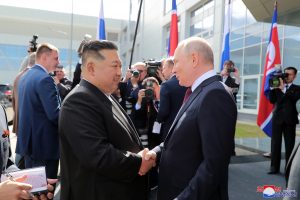
North Korea’s ties with Russia are in their steepest upswing since the Cold War. On Wednesday, September 13, Kim Jong Un held a summit with Russian President Vladimir Putin. The two are believed to have discussed expanding North Korean weapons exports to Russia. It is no coincidence that Russia’s Defense Minister Sergei Shoigu and Kim Jong Un visited a weaponry exhibit together when Shoigu was in Pyongyang in late July of this year.
Economically, it is undeniable that expanded arms trade with Russia would be a boon for North Korea. It is still unclear whether North Korea would sell off old stockpiles of weapons and ammunition to Russia or more consistently manufacture arms specifically for export for a longer time. The country’s military industry is an economic sector of significant size both in terms of production and employment, and a radical increase in weapons sales to Russia could mean a general boost for the economy through increased consumption. Gains will, however, be limited by the military industry’s isolated position in the economic structure. Many military industries source raw materials through mines and factories of their own. While several other sectors in the economy have essentially been privatized since the mid-1990s, the arms industry is entirely controlled and centrally planned by the state.
The Defense Industry Within the Economy
The most obvious economic benefit North Korea could reap from significant weapons manufacturing and sales—not just from selling off old stock to Russia—is export income, both for the state and for arms industry workers. Although the sector is far from the country’s top employer, with two million estimated workers in the defense industry, its contribution to the economy is significant. For a sense of proportion, North Korea’s 2008 census lists 4.4 million as workers in agriculture (including forestry and fishing), 718,000 in mining and quarrying, and close to three million in manufacturing.[1] A massive and sudden expansion in weapons industry activity would not drastically change North Korea’s economic situation but could make a modest contribution to economic growth and consumption.
Because the data is so unreliable, these figures should not be taken at face value. Instead, the proportions are what matter. Regardless of their exact number compared with other groups in the workforce, at an estimated two million, North Korea’s defense industry employees are enough for a drastic increase in purchase orders from Russia to boost the economy through increased wages, expanded hiring, or a combination of the two.
Major and continuous orders from Russia would benefit some parts of the military industry more than others. While the available data does not specify employment numbers for each subsector within the industry, much of North Korea’s military industry factories manufacture goods that would fall within Russia’s needs, including guns, artillery and ammunitions. These factories constitute 98 out of all 180 arms factories.[2] Factories for guns and artillery, such as the 2.8 Machine Factory, and for missile and mortar warheads, such as the Kanggye General Tractor Plant, which each have an estimated 12,000 employees respectively, are some of the industry’s largest in terms of employment.[3] These factories could well be among those assigned orders from Russia.
Big Picture Economic Impacts
A sudden, significant increase in arms exports to Russia would undoubtedly give the North Korean economy a short-term boost. How big is unclear, but likely enough to be noticeable. The majority of any profits will probably go directly to the state and the military, but workers in the industry may see their pay increased and new colleagues recruited if the orders from Russia end up being large enough or sustained for a longer period of time. All of this will have ripple effects on the overall economy, with increased consumption stimulating the consumer goods economy and service sector as well. Economic benefits are likely to be highly regional, with the impoverished Jagang Province standing out as a central beneficiary thanks to its high concentration of arms factories.
In the long run, however, North Korea’s economic benefits will likely be limited. When Russia’s warfare in Ukraine eventually winds down or ends, the demand for North Korean weapons will very likely drop as quickly as it has risen. Moreover, the military economy is independent of the “people’s economy” (often referred to as “the second economy”), operating its own factories and mines through a military-industrial complex of sorts, and does not need to turn to other sectors of the economy for raw materials and other inputs. This is designed to give the military special status in funding and budget priorities.[4] As a result, this limits potential spillover effects into other industries and diverts resources that may have otherwise been focused on developing commercial sectors. There is a long-standing debate within North Korean policymaking circles about the merits of defense spending, with some academics arguing that military spending contributes to economic development. The regime likely hopes for economic spin-off effects from developing the arms sector, but these will be limited without radical changes to the economic system.
Conclusion
Heavily increased arms exports to Russia would boost the North Korean economy in the short- to medium-term but is not a remedy for its ailing economy. The defense industry remains fully controlled by the state within an economy that is largely separated from the rest of the country. Although any export for North Korea is an important contribution, long-term economic development may be hampered by scaled-up exports to Russia, as it will further solidify inefficient economic structures.
The post What Do Weapons Sales to Russia Mean for North Korea’s Economy? appeared first on 38 North.






















